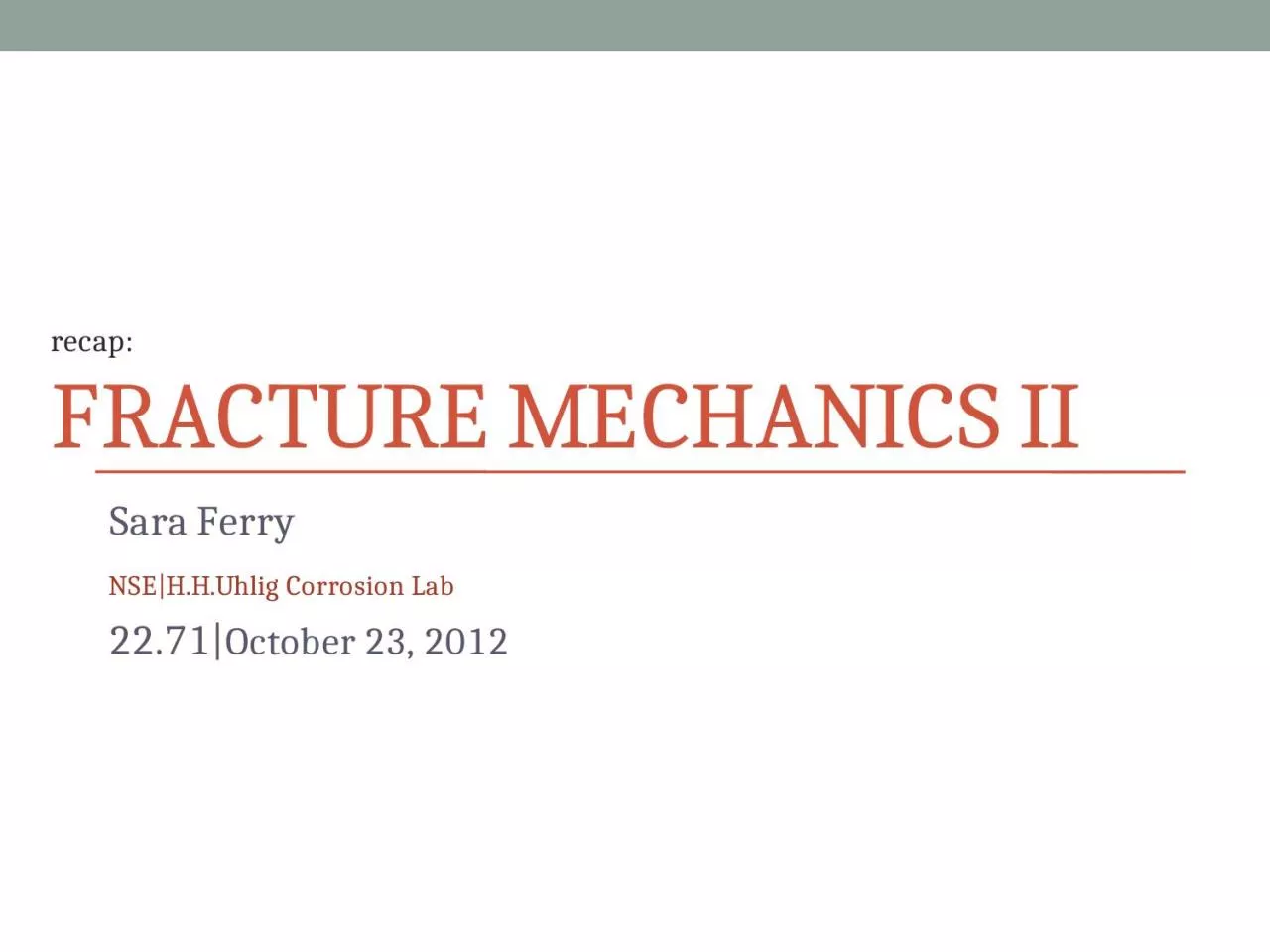

NSEHHUhlig Corrosion Lab 2271 October 23 2012 recap Griffiths vs Irwin amp Orowan but much larger Energy Release Rate Precracked Purely elastic Loaded with weight P ID: 933288
Download Presentation The PPT/PDF document "FRACTURE MECHANICS II Sara Ferry" is the property of its rightful owner. Permission is granted to download and print the materials on this web site for personal, non-commercial use only, and to display it on your personal computer provided you do not modify the materials and that you retain all copyright notices contained in the materials. By downloading content from our website, you accept the terms of this agreement.
Slide1
FRACTURE MECHANICS II
Sara Ferry NSE|H.H.Uhlig Corrosion Lab 22.71|October 23, 2012
recap:
Slide2Griffiths vs. Irwin &
Orowan(but much larger!)
Slide3Energy Release Rate
Precracked
Purely elastic
Loaded with weight P
Δ
describes displacement of weight
A
describes crack area
P
Elastic energy in the body:
How to find the form of U?
1. Solve boundary value problems using elasticity theory2. Measure experimentally
arbitrary body:
Slide4Energy release rate dU
1. Only the weight does work on the bodyThis work is stored as elastic energyCrack doesn’t changeObtain expression for change in U and integrate2.Crack increases in area, reducing elastic energy
Weight does no work
Displacement held fixed
1+2.
dU
= P
dΔ
– G dA
Slide5Fracture Energy
Most of the work done by the weight is stored as U: only some of the work goes toward inelastic processes (fracture, plastic deformation)If small scale yielding condition applies, can still find U as if the body was purely elastic
PdΔ
=
dU
+
ΓdA
Elastic processes
Inelastic processes
…and
fracture criterion
:
The crack grows if energy release rate
G = fracture energy Γ.
(fracture energy resists crack growth)
Slide6How can we measure fracture energy?
Look it up: results from previous experimentsPerform a fracture test yourselfUse a computer simulation (not standard) For common materials, you can expect to measure a
fracture energy of …
10 J/m
2
in
glass
50 J/m
2
in ceramics
103 J/m2 in polymers 10
4 J/m2 in aluminum
105 J/m2 in
steel**heat treating the steel can drastically change its fracture energy!
Slide7Potential Energy
Consider elastic body + weight P as a combined system Π
=
U – PΔ
Analogous to Gibbs free energy
.
Subbing in expression for
dU
:
dΠ = -ΔdP –
GdA, such that Π
= Π(P, A)
Slide8Linear Elasticity
There is a linear relationship between applied force P and displacement Δ. Elastic energy U =
P
Δ
/2
Potential energy
Π
= -
UEnergy release rate load fixed
Finding
G:Look it up; there are handbooks for elasticity solutions for many situations (G is specific to the configuration of the system)
Measure C using multiple identical specimens that have different crack areas. Obtain C(A), find U, and then find G (expression on next slide)Elasticity boundary-value problem (finite element program)
Slide9Compliance
Linearly elastic bodyLinear relationship between load and displacementC = compliance, is a function of crack areaOpposite of stiffness (stiffness: rigidity; resistance to deformation when force is applied)
Δ
= C(A)P
When
A
increases, compliance
C
increases.
More compliance = more elastic energy stored when load is fixed
More compliance = less elastic energy stored when displacement is fixed
Slide10Applications of Fracture Mechanics
1. Measure fracture energyIf other constants known except σc and ΓLoad a precracked
sample, record critical stress, solve for
Γ
Compare fracture energies of materials and study ways to improve fracture resistance
2. Predict critical load
Solve for
σ
c
if other values known (may have to experimentally determine Γand measure a
first) without carrying out fracture experimentUse to compare the critical load for various crack sizes (what is maximum allowable crack size)
3. Estimate flaw sizeMeasure σc
, Γ, and βa = ΓE/πσ2
4. Knowing the material that will be used, expected stresses, and typical flaw sizes, design a structure to minimize likelihood of fracture